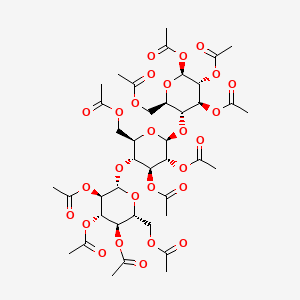



1. Triacetylcellulose
1. Triacetylcellulose
2. 9012-09-3
3. Beta-cellotriose Undecaacetate
4. Chebi:53498
5. Zinc169639103
| Molecular Weight | 966.8 g/mol |
|---|---|
| Molecular Formula | C40H54O27 |
| XLogP3 | -1.1 |
| Hydrogen Bond Donor Count | 0 |
| Hydrogen Bond Acceptor Count | 27 |
| Rotatable Bond Count | 29 |
| Exact Mass | 966.28524644 g/mol |
| Monoisotopic Mass | 966.28524644 g/mol |
| Topological Polar Surface Area | 335 Ų |
| Heavy Atom Count | 67 |
| Formal Charge | 0 |
| Complexity | 1850 |
| Isotope Atom Count | 0 |
| Defined Atom Stereocenter Count | 15 |
| Undefined Atom Stereocenter Count | 0 |
| Defined Bond Stereocenter Count | 0 |
| Undefined Bond Stereocenter Count | 0 |
| Covalently Bonded Unit Count | 1 |
Indicators and Reagents
Substances used for the detection, identification, analysis, etc. of chemical, biological, or pathologic processes or conditions. Indicators are substances that change in physical appearance, e.g., color, at or approaching the endpoint of a chemical titration, e.g., on the passage between acidity and alkalinity. Reagents are substances used for the detection or determination of another substance by chemical or microscopical means, especially analysis. Types of reagents are precipitants, solvents, oxidizers, reducers, fluxes, and colorimetric reagents. (From Grant and Hackh's Chemical Dictionary, 5th ed, p301, p499) (See all compounds classified as Indicators and Reagents.)